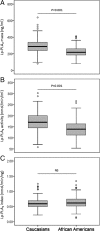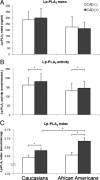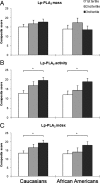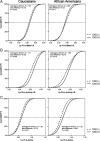Association of lipoprotein-associated phospholipase A2 with coronary artery disease in African-Americans and Caucasians
- PMID: 20194707
- PMCID: PMC2869550
- DOI: 10.1210/jc.2009-2498
Association of lipoprotein-associated phospholipase A2 with coronary artery disease in African-Americans and Caucasians
Abstract
Context: Lipoprotein-associated phospholipase A(2) (Lp-PLA(2)) is bound predominately to low-density lipoprotein and has been implicated as a risk factor for coronary artery disease (CAD).
Objective: We investigated the association between Lp-PLA(2) and CAD in a biethnic African-American and Caucasian population.
Design: Lp-PLA(2) mass, activity, and index, an integrated measure of mass and activity, and other cardiovascular risk factors were determined in 224 African-Americans and 336 Caucasians undergoing coronary angiography.
Main outcome measures: We assessed the distribution of Lp-PLA(2) levels and determined the predictive role of Lp-PLA(2) as a risk factor for CAD.
Results: Levels of Lp-PLA(2) mass and activity were higher among Caucasians compared with African-Americans (293 +/- 75 vs. 232 +/- 76 ng/ml, P < 0.001 for mass and 173 +/- 41 vs. 141 +/- 39 nmol/min/ml, P < 0.001 for activity, respectively). However, Lp-PLA(2) index was similar in the two groups (0.61 +/- 0.17 vs. 0.64 +/- 0.19, P = NS). In both ethnic groups, Lp-PLA(2) activity and index was significantly higher among subjects with CAD. African-American subjects with CAD had significantly higher Lp-PLA(2) index than corresponding Caucasian subjects (0.69 +/- 0.20 vs. 0.63 +/- 0.18, P = 0.028). In multivariate regression analyses, after adjusting for other risk factors, Lp-PLA(2) index was independently (odds ratio 6.7, P = 0.047) associated with CAD in African-Americans but not Caucasians.
Conclusions: Lp-PLA(2) activity and index was associated with presence of CAD among African-Americans and Caucasians undergoing coronary angiography. The findings suggest an independent impact of vascular inflammation among African-Americans as contributory to CAD risk and underscore the importance of Lp-PLA(2) as a cardiovascular risk factor.
Figures




Similar articles
-
Apo E4 and lipoprotein-associated phospholipase A2 synergistically increase cardiovascular risk.Atherosclerosis. 2012 Jul;223(1):230-4. doi: 10.1016/j.atherosclerosis.2012.04.021. Epub 2012 May 8. Atherosclerosis. 2012. PMID: 22632920 Free PMC article.
-
Association of Lp-PLA(2) activity with allele-specific Lp(a) levels in a bi-ethnic population.Atherosclerosis. 2010 Aug;211(2):526-30. doi: 10.1016/j.atherosclerosis.2010.03.021. Epub 2010 Apr 20. Atherosclerosis. 2010. PMID: 20444451 Free PMC article.
-
Racial variation in lipoprotein-associated phospholipase A₂ in older adults.BMC Cardiovasc Disord. 2011 Jun 29;11:38. doi: 10.1186/1471-2261-11-38. BMC Cardiovasc Disord. 2011. PMID: 21714927 Free PMC article.
-
Lipoprotein-associated phospholipase A2: an independent predictor of coronary artery disease events in primary and secondary prevention.Am J Cardiol. 2008 Jun 16;101(12A):23F-33F. doi: 10.1016/j.amjcard.2008.04.015. Am J Cardiol. 2008. PMID: 18549868 Review.
-
Review of the evidence for the clinical utility of lipoprotein-associated phospholipase A2 as a cardiovascular risk marker.Am J Cardiol. 2008 Jun 16;101(12A):41F-50F. doi: 10.1016/j.amjcard.2008.04.018. Am J Cardiol. 2008. PMID: 18549871 Review.
Cited by
-
Apo E4 and lipoprotein-associated phospholipase A2 synergistically increase cardiovascular risk.Atherosclerosis. 2012 Jul;223(1):230-4. doi: 10.1016/j.atherosclerosis.2012.04.021. Epub 2012 May 8. Atherosclerosis. 2012. PMID: 22632920 Free PMC article.
-
Serum levels of lipoprotein-associated phospholipase A2 are associated with coronary atherosclerotic plaque progression in diabetic and non-diabetic patients.BMC Cardiovasc Disord. 2024 May 14;24(1):251. doi: 10.1186/s12872-024-03931-x. BMC Cardiovasc Disord. 2024. PMID: 38745157 Free PMC article.
-
High-coverage plasma lipidomics reveals novel sex-specific lipidomic fingerprints of age and BMI: Evidence from two large population cohort studies.PLoS Biol. 2020 Sep 28;18(9):e3000870. doi: 10.1371/journal.pbio.3000870. eCollection 2020 Sep. PLoS Biol. 2020. PMID: 32986697 Free PMC article.
-
Age as a modulator of inflammatory cardiovascular risk factors.Arterioscler Thromb Vasc Biol. 2011 Sep;31(9):2151-6. doi: 10.1161/ATVBAHA.111.232348. Epub 2011 Jun 23. Arterioscler Thromb Vasc Biol. 2011. PMID: 21700927 Free PMC article.
-
Obesity and lifespan health--importance of the fetal environment.Nutrients. 2014 Apr 24;6(4):1725-36. doi: 10.3390/nu6041725. Nutrients. 2014. PMID: 24763115 Free PMC article. Review.
References
-
- Ross R 1999 Atherosclerosis—an inflammatory disease. N Engl J Med 340:115–126 - PubMed
-
- Packard CJ, O'Reilly DS, Caslake MJ, McMahon AD, Ford I, Cooney J, Macphee CH, Suckling KE, Krishna M, Wilkinson FE, Rumley A, Lowe GD 2000 Lipoprotein-associated phospholipase A2 as an independent predictor of coronary heart disease. West of Scotland Coronary Prevention Study Group. N Engl J Med 343:1148–1155 - PubMed
-
- Caslake MJ, Packard CJ 2003 Lipoprotein-associated phospholipase A2 (platelet-activating factor acetylhydrolase) and cardiovascular disease. Curr Opin Lipidol 14:347–352 - PubMed
-
- Koenig W, Khuseyinova N, Löwel H, Trischler G, Meisinger C 2004 Lipoprotein-associated phospholipase A2 adds to risk prediction of incident coronary events by C-reactive protein in apparently healthy middle-aged men from the general population: results from the 14-year follow-up of a large cohort from southern Germany. Circulation 110:1903–1908 - PubMed
-
- Ballantyne CM, Hoogeveen RC, Bang H, Coresh J, Folsom AR, Heiss G, Sharrett AR 2004 Lipoprotein-associated phospholipase A2, high-sensitivity C-reactive protein, and risk for incident coronary heart disease in middle-aged men and women in the Atherosclerosis Risk in Communities (ARIC) study. Circulation 109:837–842 - PubMed
Publication types
MeSH terms
Substances
Grants and funding
LinkOut - more resources
Full Text Sources
Miscellaneous

